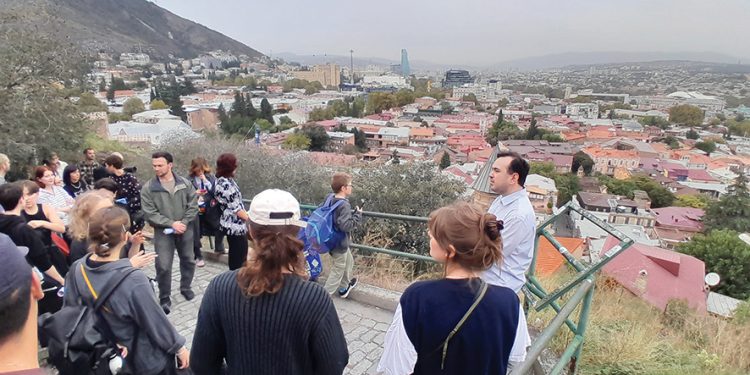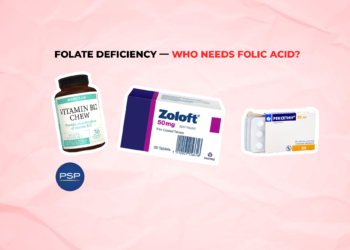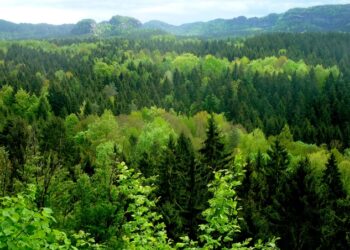The Tbilisi Urban Forest project by Ruderal was this week selected as a finalist for the European Prize for Urban Public Space, a biennial award that recognizes the best interventions of creation and transformation in the public spaces of European cities. This recognition follows from the project’s 2024 nomination for the European Union Prize for Contemporary Architecture – Mies van der Rohe Awards (EUmies Awards).
“This nomination marks the first time that the European Prize for Urban Public Space has recognized a landscape architecture work in Georgia,” says Ruderal’s director, Sarah Cowles. “The Tbilisi Urban Forest project will improve biodiversity, habitat, build resilience to climate change, and provide new recreational opportunities for Tbilisi’s residents.”
In 2020, city leaders in Tbilisi initiated a project to replant the Tbilisi Urban Forest with a biodiverse palette of endemic and climate-adapted species to replace aging pine forests. Ruderal, a Tbilisi-based landscape architecture studio, was selected to design the project by proposing a novel approach to urban forestry that integrates ecology, technology, and aesthetics.
There are two pilot areas within the 700-hectare Mtatsminda territory: Narikala Ridge, a north-facing cliffside bridging the historic city center to the National Botanical Garden of Georgia, and Okrokana, a south-facing slope in a peri-urban settlement in the hills above Tbilisi. The revitalization of Tbilisi’s urban forest has been led by the Development and Environment Foundation, under an agreement with Tbilisi City Hall and funded by the Cartu Foundation.
Ruderal adapted the work of environmental scientists to create detailed spatial plans for coherent “patches” of plant communities keyed to different soil and slope conditions. The species diversity and vertical heterogeneity of the plantings provide cover for wildlife. A leader in advanced computational methods for landscape design, Ruderal developed a parametric planting design tool to reconcile typical planting conditions with precise site-specific spatial data. The tool allows designers to rapidly visualize the patches at different scales, adapt and optimize species mixes relative to nursery inventory, and simulate the interaction of diverse species over time. Trees for the project are propagated in Georgian nurseries and collected from local seed stocks, linking to the surrounding ecological context and supporting a growing network of native plant nurseries.
At the beginning of October, within the program of the Tbilisi Architecture Biennial, Sarah Cowles and her colleagues led a guided tour of the Tbilisi Urban Forest, from Gudiashvili Square up to the Narikala Ridge, giving attendees a chance to explore the young forest and to gain a greater appreciation of the discipline of landscape architecture.
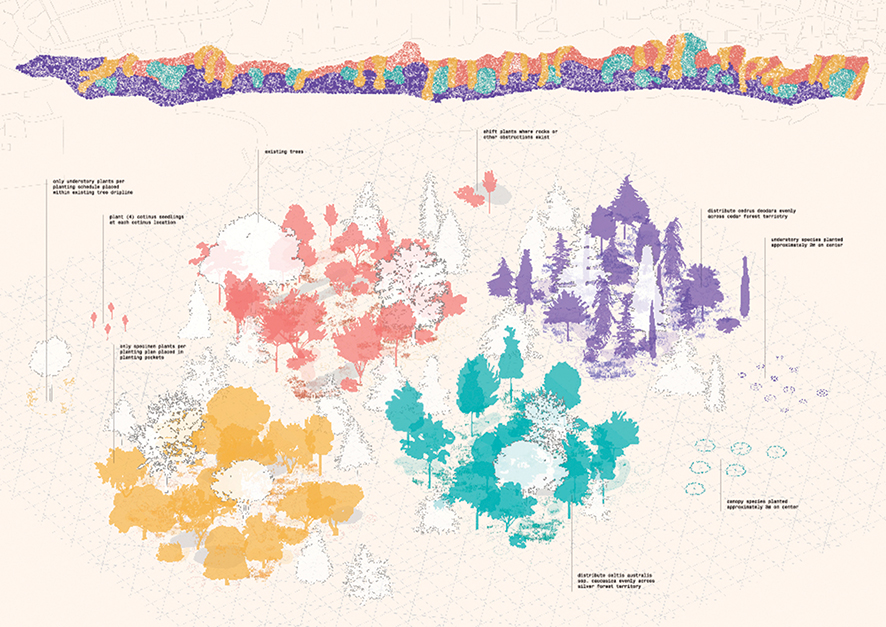
Rehabilitation of Lado Gudiashvili Square
Despite public criticism of the gentrification of the area, the rehabilitation of Lado Gudiashvili Square and its adjacent areas in Sololaki have revitalized this historic part of Old Tbilisi. Most buildings on Gudiashvili Square and in the surrounding area have been designated as immovable cultural heritage sites, and internally and externally strengthened and renovated.
The project has also improved the square, streets, and sidewalks, incorporating new lighting, underground engineering networks, and enhanced illumination on the buildings. Notably, the park in Gudiashvili Square has undergone a wonderful transformation that gives it a fresh and inviting look.
The company INSI, along with project manager Davit Kordzaia, received recognition for their exceptional contributions to the rehabilitation efforts. We met Mr. Kordzaia on our tour.
“Before our work, the square was enclosed by a retaining wall,” he tells us. “We opened up the space, integrating the life of the buildings into the area. The circular, double-sided benches we placed allow for views of both the architecture and the people passing by, as well as of Ruderal’s ‘Georgian forest’ at the center. Our goal was functionality. The steps serve as a gentle boundary between the cobbled streets and the square; the deeper steps in the lower corner helped us level the square, while two corners remain step-free to ensure accessibility for everyone.”
We asked Ruderal’s Sarah Cowles to tell us a little more about the square’s “Georgian forest,” which cleverly brings the wild of the ridge into the community space, offering visitors a sense of intimacy and natural seclusion from the busy urban surroundings.
“This little fragment of forest was a really new idea in urban planting for the city,” she notes. “The city planners are very much focused on greening right now, but they really like a certain kind of tree, certain shapes, imported trees- not very well tied into the local ecology in any way. We chose to highlight endemic species here instead, aiming to represent a fragment of Georgia’s native forest. You can see hawthorn and berries here, growing wild.”
From Gudiashvili Square, the tour moved up the beautiful Betlemi stone steps to the Narikala trail and ridge.
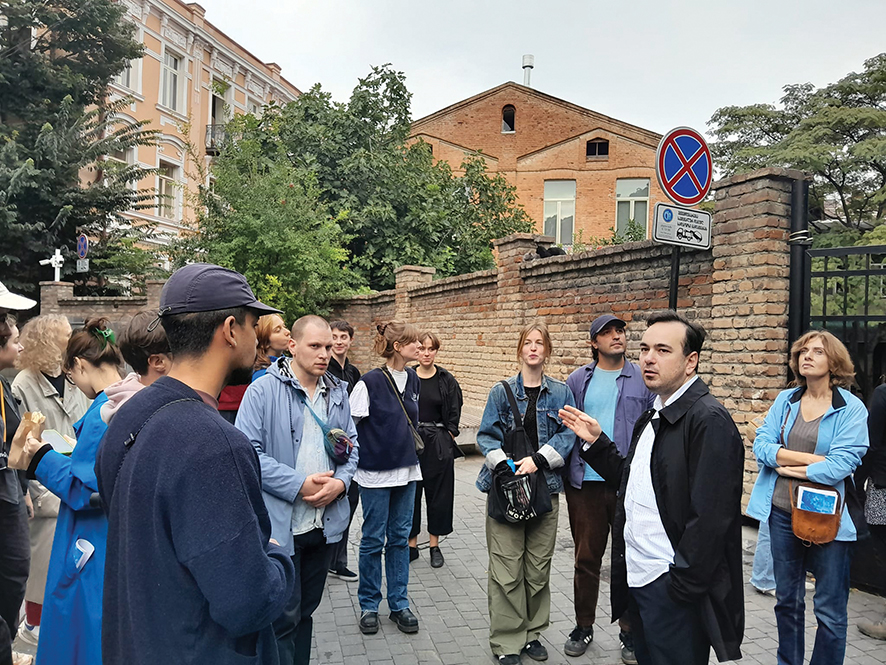 Giorgi Nishnianidze, Ruderal architect, explaining the Sololaki landscaping, old and new
Giorgi Nishnianidze, Ruderal architect, explaining the Sololaki landscaping, old and new
On the Narikala Ridge
Our first stop was half way up; a look-out point which offered wonderful views of the cityscape, including Gudiashvili Square and a former project of Ruderal’s on the Metekhi Ridge.
Giorgi Nishnianidze, architect and studio director at Ruderal, told us more: “Work on transforming the former Russian military base on the Metekhi Ridge taught us valuable lessons about applying new landscape techniques, particularly in altering existing drainage patterns,” he said. “Some of these methods were then scaled and adapted for the adjacent Narikala Project.”
The ridges around Tbilisi consist of artificially created forests. In the 1920s, the area faced a dry climate with little shade or shelter, prompting efforts to establish a forest. However, many older methods proved unsuitable for the landscape and current climate change challenges. The new initiative to restore and enhance the forest is crucial, Nishnianidze noted, with the primary focus on ensuring its sustainability over the next 50 to 100 years.
The Narikala Ridge area features the historic city wall, steep cliffs, and a popular tourist trail that begins at the Betlemi Stairs. As hikers ascend, they pass through various ecological patches, including the Cedar Forest, Silver Forest, Flowering Thicket, and Tbilisi Chaparral.
“The Narikala Ridge connects the city with the Botanical Garden, continuing the ecological narrative,” Nishnianidze said. “However, the conditions here are challenging for tree planting; the steep, rocky slopes provide little soil. In the mid-20th century, foresters used the rather brutal method of dynamiting to create planting pockets, a method that is no longer feasible due to nearby urbanization.
“Our project relies on using the existing planting pockets, densifying the greenery and introducing new patches where possible. We adopted a landscape ecology approach, planting multiple species in a single area. By analyzing the existing flora, we identified which species would thrive best together,” he noted.
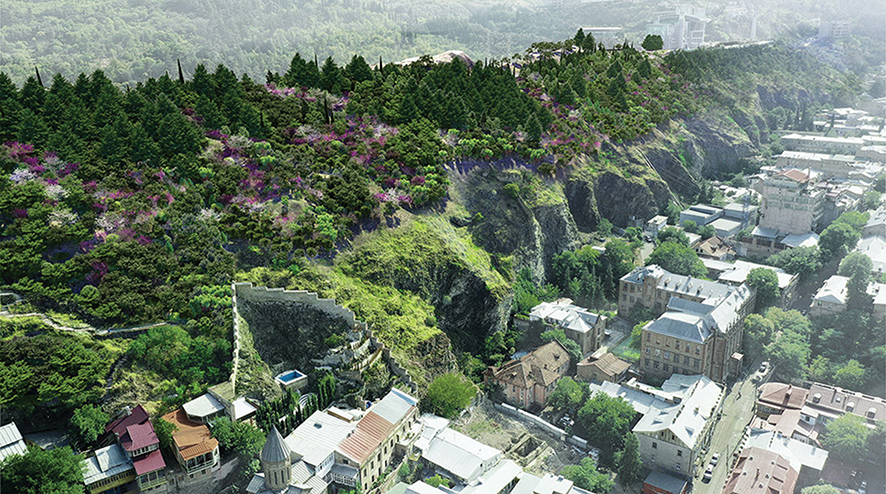
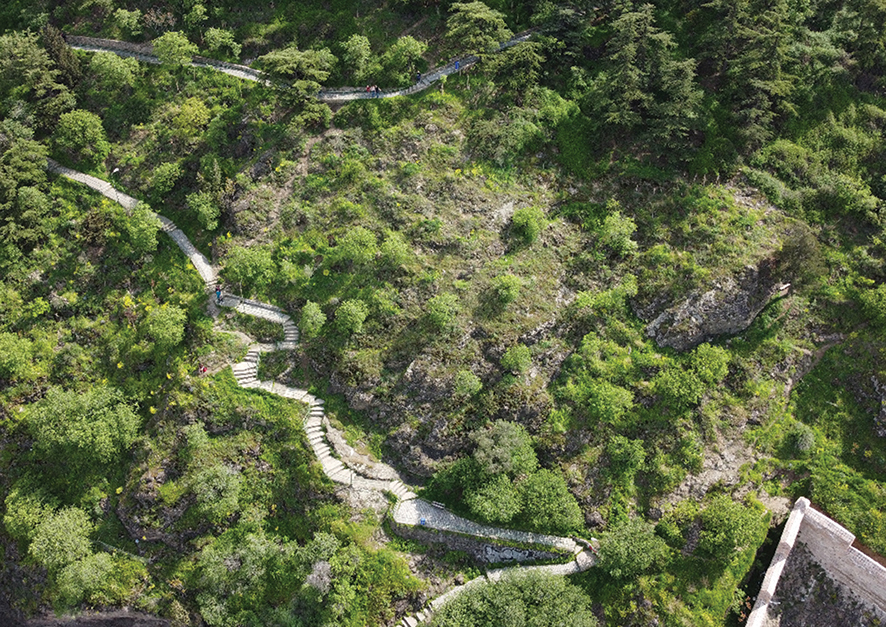
A Pause Overlooking the Botanical Garden
Before heading back down to the city, we took a break at the top of the ridge. Our eyes on the Botanical Garden, we took time to appreciate that ecological narrative Nishnianidze had mentioned.
Ruderal’s guiding principle, Sarah Cowles informs us, was to cultivate a forest with a distinctly Georgian character, moving away from the old monocultural approach that favored a single species; a strategy that was not only less biodiverse, but also ill-equipped to adapt to climate changes.
“Historically, Mtatsminda has faced a cycle of logging, planting, and replanting, with Himalayan cedar being particularly favored during the Soviet era,” Cowles says. “In recent years, the pine trees became infected with fungus, leading to the removal of the diseased trees in 2020. Much of the deadwood was repurposed to reinforce embankments and stairs on new trails across the area. Though tree mortality rates decreased towards Kojori and Betania, annual snowstorms put immense pressure on the pines, resulting in substantial damage to branches. The positive side it that this has led to natural light wells forming in the forest, allowing native Georgian deciduous trees to regenerate.”
Indeed, it seems that while pine trees inhibit much growth beneath them, they enrich the soil by increasing humus.
“When the pines were cut down on the ridge and Mtatsminda Mount, sunlight flooded in, enhancing diversity in the understory,” Cowles tells us. “Now, you can find blooming Teucrium, jasmine in the spring, and poppies, along with a range of interesting succulents. The herbaceous layer has become much more varied. However, in areas where the slope hasn’t been replanted, the risk of landslides has increased since the removal of the diseased pines. That is something that is being looked into by the city,” she assures us.
The Tbilisi Urban Forest Project is a model for sustainable and resilient urban afforestation that can be replicated in cities worldwide. The project integrates ecology, technology, and aesthetics to create a biodiverse and resilient urban forest that will benefit people and wildlife for many years to come, standing as a testimony to positively changing perspectives on city-making. If you haven’t seen it yet, do – your mind and body will thank you.
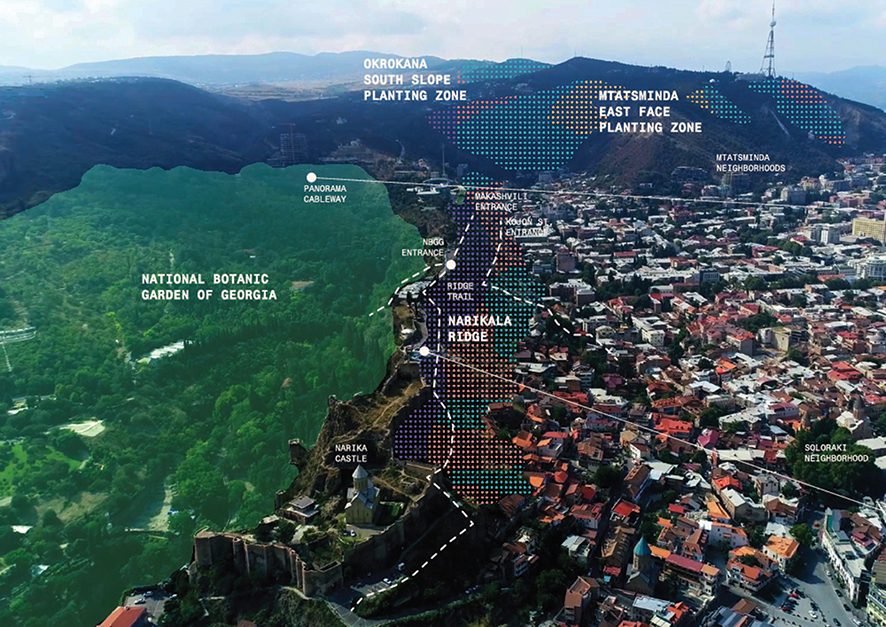
About Ruderal
Ruderal is a landscape architecture studio based in Tbilisi, Georgia that designs and develops sustainable site projects where ecology, culture, and history harmonize with the surrounding context. Ruderal works with partners with municipalities, institutions, community groups, and private developers to guide the design and planning process, from research and concept development to construction supervision.
About the European Prize for Urban Public Space
The European Prize for Urban Public Space is a biennial competition organized with the aim of recognizing and making known all kinds of works to create, recover and improve public spaces in European cities. The Tbilisi Urban Forest has been selected by an international jury as one of 5 finalists from a pool of 253 submissions. The winner will be announced later this month.
Related articles
The Tbilisi Urban Forest Rehabilitation, Exclusive Interview with Cartu Fund’s Nikoloz Chkhetiani
Tbilisi City Hall Plants 10,765 Saplings as Part of Urban Forest Restoration Project
Mtatsminda Makeover – Reviving Tbilisi’s Iconic Ridge for Generations to Come

